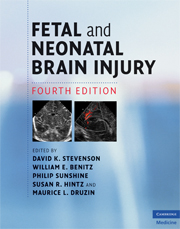Book contents
- Frontmatter
- Contents
- List of contributors
- Foreword
- Preface
- Section 1 Epidemiology, pathophysiology, and pathogenesis of fetal and neonatal brain injury
- Section 2 Pregnancy, labor, and delivery complications causing brain injury
- 5 Prematurity and complications of labor and delivery
- 6 Risks and complications of multiple gestations
- 7 Intrauterine growth restriction
- 8 Maternal diseases that affect fetal development
- 9 Obstetrical conditions and practices that affect the fetus and newborn
- 10 Fetal and neonatal injury as a consequence of maternal substance abuse
- 11 Hypertensive disorders of pregnancy
- 12 Complications of labor and delivery
- 13 Fetal response to asphyxia
- 14 Antepartum evaluation of fetal well-being
- 15 Intrapartum evaluation of the fetus
- Section 3 Diagnosis of the infant with brain injury
- Section 4 Specific conditions associated with fetal and neonatal brain injury
- Section 5 Management of the depressed or neurologically dysfunctional neonate
- Section 6 Assessing outcome of the brain-injured infant
- Index
- Plate section
- References
11 - Hypertensive disorders of pregnancy
from Section 2 - Pregnancy, labor, and delivery complications causing brain injury
Published online by Cambridge University Press: 12 January 2010
- Frontmatter
- Contents
- List of contributors
- Foreword
- Preface
- Section 1 Epidemiology, pathophysiology, and pathogenesis of fetal and neonatal brain injury
- Section 2 Pregnancy, labor, and delivery complications causing brain injury
- 5 Prematurity and complications of labor and delivery
- 6 Risks and complications of multiple gestations
- 7 Intrauterine growth restriction
- 8 Maternal diseases that affect fetal development
- 9 Obstetrical conditions and practices that affect the fetus and newborn
- 10 Fetal and neonatal injury as a consequence of maternal substance abuse
- 11 Hypertensive disorders of pregnancy
- 12 Complications of labor and delivery
- 13 Fetal response to asphyxia
- 14 Antepartum evaluation of fetal well-being
- 15 Intrapartum evaluation of the fetus
- Section 3 Diagnosis of the infant with brain injury
- Section 4 Specific conditions associated with fetal and neonatal brain injury
- Section 5 Management of the depressed or neurologically dysfunctional neonate
- Section 6 Assessing outcome of the brain-injured infant
- Index
- Plate section
- References
Summary
Introduction
Hypertensive disorders in pregnancy complicate up to 12–22% of all pregnancies and are the second leading cause of maternal deaths. They also contribute significantly to neonatal morbidity and mortality.
The National High Blood Pressure Education Program Working Group on High Blood Pressure in Pregnancy separates hypertensive disease in pregnancy into four categories: (1) chronic hypertension, (2) gestational hypertension, (3) pre-eclampsia, and (4) superimposed pre-eclampsia. This classification is an effort to create uniformity in diagnosis for diagnostic and research purposes. It is designed to describe distinct diseases with distinct pathophysiologies, and therefore distinct associated maternal and neonatal morbidity and mortality. However, hypertensive disease in pregnancy may represent a spectrum of disease, and thus the distinctions between these classifications can be blurred. This chapter will separately discuss chronic hypertension, gestational hypertension, and pre-eclampsia/superimposed pre-eclampsia and their known fetal effects. Treatment and intervention will also be discussed.
Fetal and neonatal effects of hypertension and pre-eclampsia are mainly due to alterations in placental perfusion, iatrogenic prematurity, and effects of maternal medications. In addition, there has been widespread interest in a controversial theory called the “Barker hypothesis.” This postulates that the intrauterine environment may program fetal physiology to be predisposed to specific adult diseases. Data used to support this theory include multiple retrospective studies which have correlated low birthweight (intrauterine growth restriction, IUGR) to multiple diverse adult diseases ranging from hypertension, coronary artery disease, and type 2 diabetes to depression and schizophrenia.
- Type
- Chapter
- Information
- Fetal and Neonatal Brain Injury , pp. 127 - 133Publisher: Cambridge University PressPrint publication year: 2009
References
- 1
- Cited by



